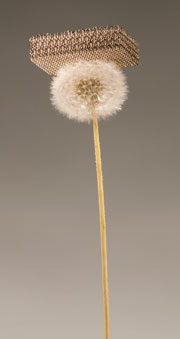Metallic microlattice is a synthetic porous metallic material, consisting of an ultra-light metal foam. With a density as low as 0.9 kg/m3 (0.00561 lb/ft3), it is one of the lightest structural materials known to science.It was developed by a team of scientists from California-based HRL Laboratories, in collaboration with researchers at University of California, Irvine and Caltech, and was first announced in November 2011. The prototype samples were made from a nickel-phosphorus alloy.In 2012, the microlattice prototype was declared one of 10 World-Changing Innovations by Popular Mechanics.Metallic microlattice technology has numerous potential applications in automotive and aeronautical engineering.
Dubbed as the world’s lightest metal, the microlattice is 100 times lighter than Styrofoam, and is so lightweight that it can be balanced on top of a dandelion, scientists say.
Boeing, an aerospace company known for its airplanes, rotorcraft, rockets and satellites, released a video of the microlattice metal first developed by a team of scientists from the University of California, Irvine, HRL Laboratories and the California Institute of Technology in 2011.

The microlattice is an interconnected criss-cross of hollow tubes positioned in diagonal patterns. Dr. Tobias Schaedler, lead author of the study published in the journal Science, said that each polymer structure has a thickness of 100 nanometers which makes it 1,000 times thinner than a strand of human hair. The initial prototypes for the microlattice were made from a nickel-phosphorus alloy.
To create the structure, a polymer template is first produced by placing a mask patterned with circular holes over a reservoir of a photosensitive thiol-ene monomer. UV light is shone on the mask and where the light meets the monomer it polymerises it. ‘As the light begins to polymerise the liquid monomer, the change in refractive index between the polymer and monomer begins to tunnel the light, just as in a fibre optic,’ says Schaedler. ‘This leads to the formation of a self-propagating photopolymer waveguide, or fibre, within the monomer reservoir. We form these waveguides in multiple directions and intersect them together to create an interconnected network. Then we clean out the uncured liquid monomer with a solvent, and the result is a micro-lattice structure, where the self-propagating waveguides are the individual structural lattice members.’
This lattice template is then dipped in a catalyst solution before being transferred to a nickel-phosphorus solution. The nickel-phosphorus alloy is then deposited catalytically on the surface of the polymer struts to a thickness of around 100nm. Once coated, the polymer is etched away with sodium hydroxide, leaving an identical lattice geometry of hollow nickel-phosphorus tubes.
“By changing the structure at these levels you get completely different properties from the bulk material, which is a very powerful concept,” said Schaedler.
Sophia Yang, research scientist at HRL Laboratories, explained that the microlattice is mostly 99.99% air. In the video, she compared the microlattice to the structure of human bones where the outside is very rigid while the inside is mostly hollow. Because of this, bones aren’t easily crushed but are lightweight, she said.
Yang also discussed the microlattice’s potential uses. She said that it can possibly be applied in heat transfer, shock absorption or structural reinforcement. The microlattice can be possibly developed into a component used in airplanes, which would make the aircraft become more lightweight and more fuel-efficient.
